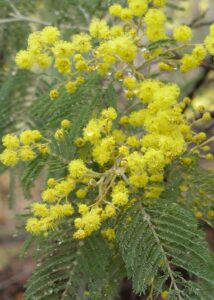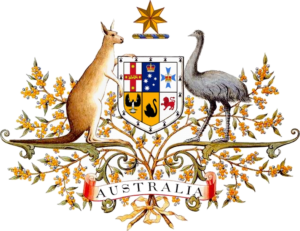Before and after Federation to 1912
In colonial Australia, before Federation in 1901, the first known use of wattle as a meaningful emblem in the Australian colonies dates back to the early days of Tasmania (1838), when the wearing of silver wattle sprigs was encouraged on the occasion of an anniversary celebration of the seventeenth century European discovery of the island.

Silver Wattle (Acacia dealbata) Photo: © S. D. Searle
More than a century later, near the end of the nineteenth century, naturalistic imagery of Australian flora and fauna began to appear on utilitarian objects such as furniture. This was a reflection of intensifying nationalism as the colonies considered their progress towards Federation. In October 1889, a short-lived ‘Wattle Blossom League’ had a preliminary meeting in Adelaide. The chief proposer was a Mr Will Sowden, Vice-President of the Adelaide branch of the Australian Natives Association. The League got as far as having a Wattle Blossom Social in the Adelaide Town Hall (March 1890). It also designed its own flag in January 1891. Later that year, however, some prominent members of the League withdrew and it dissolved.
The SA League’s activities had not escaped notice in Melbourne. In February 1891 there was an article on national symbols in The Melbourne Herald which in part was responding to Canada’s choice of the maple leaf as national emblem. A proposal that wattle should become the Australian emblem was printed.
The next significant event was the formation in 1899 of a ‘Wattle Club’ in Victoria by Mr A. J. Campbell, a field naturalist. For several years the club organised bush outings on the first day in September. The first suggestion of a Wattle Day was made by Mr Campbell during a speech in September 1908.
Meanwhile, Sydney was not to be left behind. The then Government Botanist (J. H. Maiden), a specialist in wattles (Acacias), became most interested in the movement in favour of a Wattle Day. An August 1909 public meeting held to form a Wattle Day League accepted a motion of his advocating the
setting apart throughout the Commonwealth a day on which
the Australian national flower – the Wattle Blossom – might
be worn, and its display encouraged.
The meeting also agreed to encourage the coordination of all States in this endeavour.
For some time, especially in NSW, there had been a debate as to whether Wattle or the Waratah should be Australia’s national floral emblem. By around 1910, consensus finally favoured Wattle since it grows throughout the nation whereas the Waratah is limited in distribution.
By July 1910 a branch of the Wattle Day League was started in South Australia, with Will Sowden as its Vice-President. Another branch was commenced in Melbourne by A. J. Campbell in September of that year. The first ‘national’ Wattle Day was celebrated in Sydney, Melbourne and Adelaide on the First of September 1910. The Adelaide branch is described as particularly active, and was notable for promoting wattle as an emblem on other occasions besides Wattle Day. Early Wattle Day activities included planting of wattle trees in school grounds, school lessons on botany, street decorations of wattle blossom, and wearing sprigs of wattle, often sold for charity.
Wider acceptance of a national Wattle Day was achieved at a major Australian Wattle Day League Conference in Melbourne in January 1913. Branches were formed in a number of States, with the general aim of officially proclaiming wattle as the national floral emblem and extending Wattle Day celebrations throughout the nation. About this time, wattle was officially introduced to representations of the Commonwealth coat-of-arms. And in December of the same year, the first wattle blossom stamp was issued.
Wattle has graced Australia’s Coat of Arms since 1912
The current Commonwealth Coat of Arms was granted under Royal Warrant by King George V on 19 September 1912. Prime Minister Andrew Fisher had changed the 1908 Australian Coat of Arms to include more relevant Australian symbols representing the states and including two branches of wattle as the background ornamental feature. The wattle appears to be a stylised wattle; not intended to represent any particular species of wattle.

Image courtesy of:
http://www.itsanhonour.gov.au/coat-arms/#Images
Even as public support for Wattle Day reached a peak, World War I broke out. Wattle took on a new significance in the war years as a potent symbol of home for military personnel serving overseas, and as a means of raising money for organisations such as the Red Cross. Beautifully designed Wattle Day badges as well as wattle sprigs were sold.
In 1916 the date of Wattle Day was changed in New South Wales to the first of August. This was done because wattle blooms profusely about that time in the surrounds of Sydney. However, the change led to some confusion which persists to this day; note that the nationally agreed date of Wattle Day has been the First of September throughout Australia since 1992.
Wattle Day continued to be celebrated during the 1920s and 1930s, although apparently not in Western Australia or the Northern Territory. The Day became largely associated with schools and tree planting, the aftermath of the War perhaps softening some of the patriotic fervour characteristic of the early days of Federation.
For some reason, World War II is not recorded as having greatly revived the tradition of Wattle Day; wattle does not seem to have been widely used as a symbol of Australia in that time of national crisis. At any rate, following the war, Wattle Day slowly faded as a tradition. It was not until the 1980s that national pride and symbolism re-emerged in the lead-up to the 1988 bicentennial celebrations.
